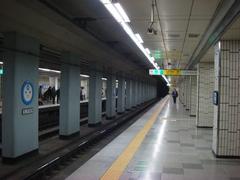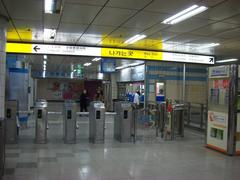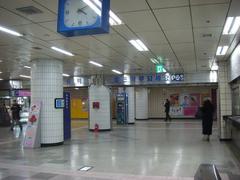
Suyu Station Seoul: Visiting Hours, Tickets, and Tourist Guide
Date: 15/06/2025
Introduction to Suyu Station: History and Significance
Suyu Station, nestled in the energetic Suyu-dong neighborhood of Seoul’s Gangbuk District, is a vital gateway for both locals and travelers. As an important stop on Seoul Metropolitan Subway Line 4, Suyu Station connects the city center to its northern districts, providing easy access to vibrant cultural landmarks, local markets, and serene natural escapes. The area, once a rural village called Suyu-ri before its incorporation into Seoul in 1949, exemplifies the city’s dramatic transformation from rural landscapes to a thriving urban center (Wikipedia: Suyu-dong).
Today, Suyu Station serves not only as a transportation hub but also as an entry point to Gangbuk-gu’s rich historical and cultural tapestry. Landmarks such as the Suyu Monument and Ssangmun Monument stand as testaments to the area’s resilience, commemorating significant events and serving as venues for community festivals and cultural programs (Seoul Cultural Heritage, Gangbuk-gu Cultural Heritage). Visitors can also enjoy nearby traditional markets, lively nightlife districts, and access to scenic parks and hiking trails.
Whether you are a history enthusiast, nature lover, or foodie, Suyu Station offers authentic experiences beyond the typical tourist trail. This guide provides comprehensive information for planning your visit, covering operating hours, ticketing, accessibility, local attractions, dining, events, and more. For additional details and real-time updates, consult the Seoul Metro and Visit Seoul Tourism websites.
Table of Contents
- Introduction to Suyu Station and Surrounding Monuments
- Historical Evolution and Cultural Significance
- Practical Visitor Information
- Nearby Attractions and Experiences
- Guided Tours and Special Events
- Photographic Spots and Visual Media
- Visitor Tips and FAQs
- Accommodation Options
- Conclusion and Recommendations
Historical Evolution and Cultural Significance
Suyu Neighborhood
Originally known as Suyu-ri, the area was incorporated into Seoul in 1949, evolving rapidly alongside the capital’s post-war expansion (Wikipedia: Suyu-dong). The development of Suyu Station on Line 4 further catalyzed this transformation, supporting residential growth and fostering a vibrant local community.
Suyu Monument
Erected in 1985, the Suyu Monument honors the resilience and spirit of the Suyu neighborhood. Its sculptures and inscriptions narrate local legends and historical milestones, offering both a tribute to the past and a gathering place for modern cultural events. The monument is set within tranquil gardens, making it a peaceful spot for reflection and photography (Seoul Cultural Heritage).
- Opening Hours: 9:00 AM – 6:00 PM daily
- Admission: Free
- Guided Tours: Available on weekends and public holidays at 11:00 AM and 3:00 PM (advance booking recommended via the official website)
Ssangmun Monument
The Ssangmun Monument commemorates the area’s historical significance, especially during the Joseon Dynasty, and is characterized by traditional Korean architectural elements and stone carvings. Informational plaques in Korean and English provide historical context (Gangbuk-gu Cultural Heritage).
- Opening Hours: 9:00 AM – 6:00 PM daily
- Admission: Free
- Accessibility: Wheelchair accessible, with paved pathways and ramps
Practical Visitor Information
- Suyu Station Hours: Approx. 5:30 AM – midnight daily, with trains every 5 minutes during peak hours (Seoul Metro)
- Tickets: Single-ride tickets, rechargeable T-money cards, and contactless payment options are available at the station. T-money cards are recommended for convenience across Seoul’s transport network.
- Accessibility: Suyu Station is equipped with elevators, tactile paving, accessible restrooms, and ramps.
- Getting There: Accessible via Line 4. Exit 6 leads to the Suyu Monument; Exit 3 is closest to the Ssangmun Monument.
Nearby Attractions and Things to Do
Suyu Traditional Market
A bustling marketplace where visitors can sample authentic Korean street foods and shop for fresh produce, specialty goods, and handmade crafts. Open daily from 10:00 AM – 10:00 PM, the market is especially lively in the evenings and on weekends (Trip.com).
Neon Alley
Just outside Exit 7, Neon Alley features dazzling lights, themed restaurants, quirky bars, and love motels—making it a hotspot for Seoul’s nightlife (Seoulistic). The area stays busy late into the night.
Cafés and Culinary Highlights
- Geunal (그날): A cozy wine bar near Exit 7, perfect for an intimate evening (Clumsy in Korea).
- Penelope (페넬로페): A European-inspired brunch and dining pub near Exit 5 (Penelope).
- Masi Meats (마시미트): Known for German-style sausages and schnitzels, located near Miasageori Station (Clumsy in Korea).
- Espere Coffee and Bamboo Resort Café: Popular for their blend of traditional and modern Seoul flavors.
Parks and Natural Escapes
- Uicheon Stream: An 8-kilometer stream offering serene walking and cycling paths (Clumsy in Korea).
- Odong Park & Dream Forest: Walking trails, art installations, and seasonal gardens. Dream Forest is especially popular during cherry blossom season and autumn foliage (Clumsy in Korea).
- Solbat Park: Noted for its pine forest and peaceful picnic areas.
- Bukhansan National Park: A short ride from Suyu, this park offers hiking trails, temples, and panoramic views—all free to access (Clumsy in Korea).
Art, Culture, and Community Events
- Ui-Sinseol LRT Art Stations: Several stations along the Ui LRT line serve as mini art galleries, featuring murals and installations (Clumsy in Korea).
- Festivals: Community events and traditional performances are held in local parks during major Korean holidays.
Guided Tours and Special Events
Guided tours of the Suyu and Ssangmun Monuments are available on weekends and public holidays, with advance reservation recommended. Cultural centers also organize tours that include local markets and parks. Seasonal festivals, music performances, and workshops frequently take place at these historic sites (Seoul Cultural Heritage).
Photographic Spots and Unique Experiences
Capture the area’s unique blend of urban energy and natural beauty—especially the monuments during golden hour, Dream Forest’s seasonal blossoms, and panoramic views from Bukhansan. Local markets and Neon Alley also provide vibrant backdrops for street photography.
Visitor Tips and FAQs
- Wear comfortable shoes—many attractions involve walking.
- Bring a camera for the monuments, markets, and parks.
- Use navigation apps like Kakao Map.
- Carry some cash for market stalls, but credit cards are widely accepted.
- Visit in spring or autumn for the best natural scenery.
Frequently Asked Questions (FAQ)
Q: What are Suyu Station’s operating hours?
A: 5:30 AM – midnight daily.
Q: How do I buy subway tickets?
A: Purchase at kiosks in the station or use a T-money card.
Q: Are monuments accessible for people with disabilities?
A: Yes, both Suyu and Ssangmun Monuments are wheelchair accessible.
Q: Is there an entrance fee for major attractions?
A: Most attractions, including the monuments and parks, are free to enter.
Q: Are guided tours available?
A: Yes, at monuments on weekends and public holidays. Advance booking is suggested.
Accommodation Options Near Suyu Station
A range of accommodations are available, from budget motels to boutique hotels. Yuria Hotel, about 450 meters from Exit 4, is popular for its modern amenities (Clumsy in Korea).
Visual Media and Maps
Official maps and virtual tours are available on the Seoul Metro and Visit Seoul Tourism websites. Social media channels offer photo galleries and visitor experiences.
Conclusion
Suyu Station and its surroundings offer a harmonious blend of history, culture, and modern urban life in northern Seoul. From the storied Suyu and Ssangmun Monuments to lively markets, contemporary cafes, and access to scenic parks, visitors can experience authentic Seoul away from the crowds of downtown. The district’s excellent public transport connections, accessible amenities, and vibrant community spirit make it an ideal destination for travelers seeking immersion in local culture.
To get the most out of your visit, use a T-money card for seamless transit, plan your itinerary around seasonal highlights, and consider guided tours for deeper insights. For ongoing updates, event information, and personalized recommendations, consult the Seoul Metro and Visit Seoul Tourism websites.
Start your journey at Suyu Station and discover the history, natural beauty, and unique character that define this dynamic corner of Seoul.
References
- This guide draws on information from Seoul Metro, Seoul Cultural Heritage, Gangbuk-gu Cultural Heritage, Clumsy in Korea, Wikipedia: Suyu-dong, Visit Seoul Tourism, Trip.com, Seoulistic, and Penelope.
















































































































































































































